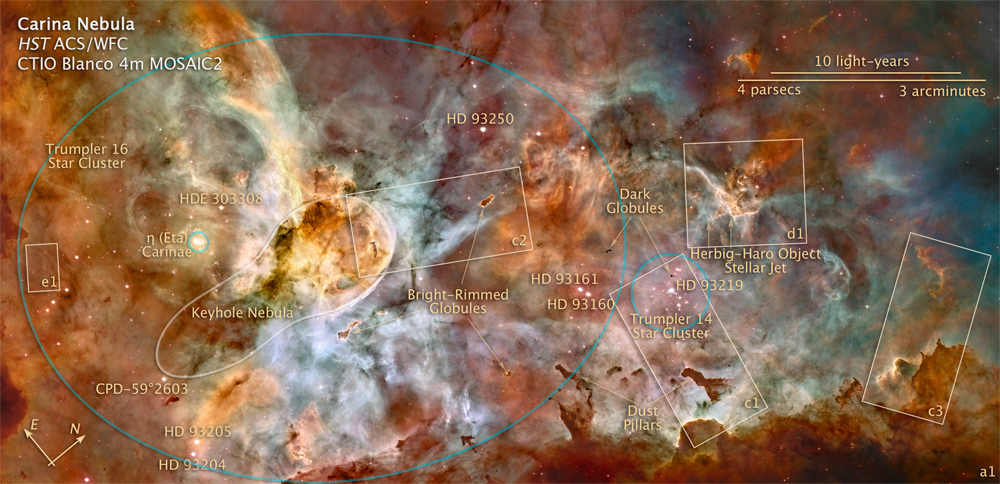|
Carina Nebula
The Carina Nebula or Eta Carinae Nebula (catalogued as NGC 3372; also known as the Great Carina Nebula) is a large, complex area of bright and dark nebulosity in the constellation Carina, located in the Carina–Sagittarius Arm of the Milky Way galaxy. The nebula is approximately from Earth. The nebula has within its boundaries the large Carina OB1 association and several related open clusters, including numerous O-type stars and several Wolf–Rayet stars. encompasses the star clusters and . is one of the youngest known star clusters at half a million years old. is the home of , currently the most luminous star known in our Milky Way galaxy, together with the less luminous but more massive and famous Eta Carinae star system and the O2 supergiant . , , , , and are also considered members of the association. is the oldest and furthest from , indicating sequential and ongoing star formation. The nebula is one of the largest diffuse nebulae in our skies. Although it i ... [...More Info...] [...Related Items...] OR: [Wikipedia] [Google] [Baidu] |
Eta Carinae
Eta Carinae (η Carinae, abbreviated to η Car), formerly known as Eta Argus, is a stellar system containing at least two stars with a combined luminosity greater than five million times that of the Sun, located around distant in the constellation Carina. Previously a 4th-magnitude star, it brightened in 1837 to become brighter than Rigel, marking the start of its so-called "Great Eruption". It became the second-brightest star in the sky between 11 and 14 March 1843 before fading well below naked eye visibility after 1856. In a smaller eruption, it reached 6th magnitude in 1892 before fading again. It has brightened consistently since about 1940, becoming brighter than magnitude 4.5 by 2014. At declination −59° 41′ 04.26″, Eta Carinae is circumpolar from locations on Earth south of latitude 30°S, (for reference, the latitude of Johannesburg is 26°12′S); and is not visible north of about latitude 30°N, just south of Cairo, which is at a latitude ... [...More Info...] [...Related Items...] OR: [Wikipedia] [Google] [Baidu] |
Carina OB1
Carina OB1 is a giant OB association in the Carina Nebula, which is home to some of the most massive and luminous stars in the Milky Way Galaxy. It includes the young star clusters Collinder 228, NGC 3293, NGC 3324, IC 2581, Trumpler 14, Trumpler 15 and Trumpler 16, the last being the home of Eta Carinae. It also includes another massive and luminous star, HD 93129A. It is approximately from Earth. It is one of the largest known stellar associations, along with Sagittarius OB5 and Cygnus OB2 Cygnus OB2 is an OB association that is home to some of the most massive and most luminous stars known, including suspected Luminous blue variable Cyg OB2 #12. It also includes one of the largest known stars, NML Cygni. The region is em .... It is much easier to see than that of the other associations since Carina OB1 has relatively little dust extinction in its region. Together with Carina OB2, they compromise the most massive stellar grouping known in the galaxy. C ... [...More Info...] [...Related Items...] OR: [Wikipedia] [Google] [Baidu] |
Collinder Catalog
In astronomy, the Collinder catalogue is a catalogue of 471 open clusters by Swedish astronomer Per Collinder. It was published in 1931 as an appendix to Collinder's paper ''On structural properties of open galactic clusters and their spatial distribution''. Catalogue objects are denoted by ''Collinder'', e.g. "Collinder 399". Dated prefixes include as ''Col + catalogue number'', or ''Cr + catalogue number'', e.g. "Cr 399". Vital statistics * The catalogue contains 471 objects: 452 open clusters, 11 globular clusters, 6 asterisms, 1 stellar moving group, and 1 stellar association. * Objects are spread out across the entire celestial sphere. * Cr 8 is the northernmost Collinder object, located at a declination of +85º in the constellation Camelopardalis. * Cr 411 is the southernmost Collinder object, located at a declination of -79º in the constellation Octans. Collinder objects which are also Messier objects The Collinder Catalogue contains 29 objects which are part of the ... [...More Info...] [...Related Items...] OR: [Wikipedia] [Google] [Baidu] |



